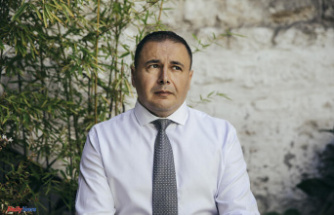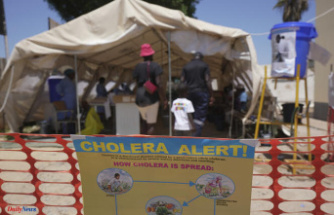The Mar Menor is saved from death... for the moment
On the border with Portugal there is an invisible barrier, insurmountable to the vultures. It is a wall that cannot be seen from the air, but the necrophagous birds collide against him, as the swallows that are stamped against the glass of a window. The map that draw the millions of GPS points from the issuers that the scientists put them both scavenger species -black vulture and griffon - transforms a political border into an ecological barrier. The vultures do not want to cross over to Portugal. These results -published this year by the team of the researcher of the Biological Station of Doñana by José Antonio Donázar in the journal Biological Conservation - responding to a cause socio-political rather than ecological, but tell the story of how the efforts of scientists and naturalists to foot of field can bend the arm of iron, of Brussels, in some cases, and to do that you lift the foot from the neck of some threatened species.
In the year 2001, following the bse crisis, the European Commission banned the abandonment in the mountain of the corpses of cattle. They had to be burned or buried. That measure put against the strings to the birds that feed on carrion, including some in danger of extinction such as the black vulture or the lammergeyer. This prompted a strong reaction from researchers, environmentalists, and local technicians of the Administration to explain in Brussels the damage that he did that measure of the biodiversity in the Iberian peninsula. And the EU reacted: in 2005 he began to loosen the legislation, he stretched the hand, and these birds were able to breathe again. But only in the countries where they wanted to do something for these animals. The new laws were not enforceable. Portugal continues anchored in a very restrictive policy with the corpses legacy of that health crisis of 20 years ago and Spain is not. From there, that invisible barrier that rises hundreds of meters above the surface of both countries.
class="icon-foto_16_g"> iberian Pig in the mountain. ALBERTO DI LOLLIAnd it is not a question of presence, if not of number. "This was a cattle ranch that sought only economic profitability, and the owner got all the cattle they could," says Carlos Sanchez while going through the estate of Campanarios de Azaba, on the border of salamanca with Portugal. "Here what we have done is a de-intensification of the livestock to regenerate the pasture and recover biodiversity".
The landscape changes nothing more to cross the fence out of the 600 hectares of the biological reserve that protects the foundation directed by Sanchez nearly 10 years ago. The dehesa, in the neighbouring estates clean as a carpet between the foot and the foot of holm oak (Quercus ilex), still hints at the vegetation that is regenerating under the shade of the older trees. But step back and look at it from far away. In the foreground, the broom and holm oaks, small promise of a future in this mediterranean forest, distracted too much to remember that, years ago, that was a tapestry eaten and trampled by livestock.
The project has been a resounding success, and proof of this is the Award BBVA Foundation to the Conservation of Biodiversity, which he picked up yesterday Carlos Sanchez of the hands of the president of the entity, Francisco Gonzalez. But to do this it has had to focus efforts on private property. The greater part of its activity is focused on estates purchased by his own foundation -as the Campanarios de Azaba or another of 500 hectares in the Sierra de Gata and in which there are more than 40 nests of black vulture - thanks to european funds and the private donors who have understood the need to create these reserves for biodiversity. One of them was also the saviour of Doñana, Luc Hoffman, the billionaire owner of the Roche laboratories and patron of the MAVA Foundation dedicated to finance projects for the conservation of nature all over the world, who in fact visited with his family the Biological Reserve Campanarios for a week, shortly before his death, and became fascinated. In fact, the recovery of the area became in a short time in the first reserve entomological -insects - of-Spain.
class="icon-foto_16_g"> aerial Image of a dehesa in Western Iberian. STAFFAN WIDSTRANDThis social reality so hard has its positive counterpart for the nature. The low density of population and the low pressure imposed by the lack of infrastructure of communication allows you to still maintain levels of biodiversity exceptional. For Sanchez, the sustainable management of these forests is the only way to avoid these two extremes, the abandonment and the intensification of the livestock. If you are going to exploit a territory, which will ensure that you will be able to continue exploiting in the future; and if it has been left uninhabited, will have to find a way to keep it, to avoid risks such as forest fires and to obtain an economic return.
ecotourism is the way that has been found Sanchez for turning lack of resources into an opportunity for the area. Campanarios de Azaba is one of the best places to find species such as black vulture, genets, el milano real, the black stork or the marten, among many others. A lodge and a network of hides to watch and photograph species has already begun to bear fruit and the influx of naturalists (especially central europe) is almost constant throughout the year and constitutes a new source of funding for the foundation directed by Sanchez. A new opportunity for sustainable depressed area on both sides of the border. And a new way of looking at the rural areas, which could serve to tear down that invisible wall that separates Spain and Portugal.
Award for defense of biodiversityThe BBVA Foundation to the Conservation of the Biodiversity carried 13 years ago, recognizing the work of the best initiatives of defense of the nature. This year, for the first time, has included a world-class that have been awarded by the Foundation Moises Bertoni for the Conservation of Nature of Paraguay. In addition to the reconociemiento to the Foundation Nature and Man, the journalists Rafael Serra, José Antonio Montero and Miguel Miralles won the prize of the Dissemination of Knowledge by their work in the magazine Quercus.
"Before the conservation work was limited to organizations in the minority. Fortunately, today the public has internalized many elements of the conservation vision," said the president of the BBVA Foundation, Francisco González, during the award ceremony."We have a broad spectrum of organizations, local, about, global, other, able to give life to meaningful programs, sometimes through forms of collective action and demands to the decisores public and private, other driving and managing programs to conservation. Both strategies are essential given the magnitude of the challenges addressed in this first part of the TWENTY-first century," he said.
According to the criteria of
Learn more Date Of Update: 15 December 2018, 08:01











